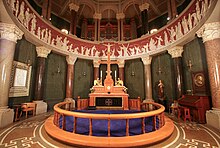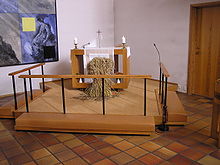អាសនា
អាសនា (អង់គ្លេស: Altar) ជាកន្លែងថ្វាយតង្វាយដុត នៅក្នុងព្រះវិហារ។ ជាអ្វីដែលគេសង់ឡើងសម្រាប់ជាទីថ្វាយតង្វាយ ដូចជាយញ្ញបូជាជាដើម សម្រាប់គោលបំណងសាសនា។
ជាធម្មតា អាសនាត្រូវបានគេឃើញមាននៅតាមស្តូបនានា ហើយវាអាចស្ថិតនៅក្នុងព្រះវិហារ និងកន្លែងថ្វាយបង្គំផ្សេងៗទៀតដែរ។ សព្វថ្ងៃនេះ អាសនាត្រូវបានប្រើនៅក្នុងសាសនាគ្រីស្ទ សាសនាព្រះពុទ្ធ សាសនាហ៊ីនឌូ សាសនាស៊ីនតូ និងសាសនាតៅជាដើម។
ព្រះគម្ពីរហេព្រើរ
[កែប្រែ]អាសនា (ភាសាហេព្រើរ ហេប្រឺ ៖ מזבח, mizbe'ah, "កន្លែងសម្លាប់សត្វដើម្បីធ្វើយញ្ញបូជា ឬ កន្លែថ្វាយយញ្ញបូជា")[១] តាមរយៈព្រះគម្ពីជាភាសារហេព្រើរបានឲ្យដឹងថា អាសនាជាទូទៅធ្វើពីដី ឬពីថ្្មដែលគ្មានរាងកំណត់ច្បាស់លាស់។[២][៣] ជាទូទៅ អាសនាត្រូវបានគេដាក់បញ្ឈរនៅកន្លែងដែលអាចមើលឃើញច្បាស់[៤][៥][៦][៧] អាសនាដំបូង ត្រូវាបានកត់ត្រាក្នុងព្រះគម្ពីជាភាសាហេព្រើរ ដែលត្រូវបានដាក់បញ្ឈរដោយណូអេ។[៨] ដោយអ័រប្រាហាំ[៩] ដោយអ៊ីសាក[១០] ដោយយ៉ាកុប[១១] និងដោយម៉ូសេ[១២]។
សាសនាគ្រីស្ទ
[កែប្រែ]ពាក្យ "អាសនា" នៅក្នុងភាសាក្រិក θυσιαστήριον (សូមមើល:θυσία), មានប្រើ២៤ដង នៅក្នុងព្រះគម្ពីរសញ្ញាថ្មី។ ជាពិសេស នៅកណ្ឌគម្ពីរហេព្រើរ 13:10 [១៣] បង្ហាញឲ្យឃើញថា គ្រីស្ទានមានអាសនាមួយដែលពួកអ្នកមិនជឿព្រះយេស៊ូវមិនអាចចូលរួមបានឡើយ។
[១៤][១៥][១៦][១៧][១៨][១៩][២០][២១][២២][២៣][២៤][២៥][២៦][២៧]
ព្រះវិហារប្រូតេស្តង់
[កែប្រែ]
មានអាសនាផ្សេងៗគ្នាជាច្រើនក្នុងនិកាយប្រូតេស្តង់។ ព្រះវិហារខ្លះ ដូចជាលូធើរ៉ាន( Lutheran), មានអាសនាជាច្រើនស្រដៀងគ្នាអាសនារបស់ខាងអង់គ្លីកង់ (Anglican )ឬ កាតូលិច ដែលគេប្រើសម្រាប់ពិធីលៀងព្រះអម្ចាស់ (Lord's Supper)។ ព្រះវិហាររបស់ពួកកាលវិន បាបទីស្ទ ខនហ្គ្រីហ្គេសិនណល និងក្រុមដែលគ្មាននិកាយ ព្រះវិហារទាំងនេះគ្មានអាសនាទេ ប៉ុន្តែគេមានតុសម្រាប់ធ្វើពិធីប្រកបគ្នា (Communion Table) ជំនួសវិញ ដែលតុនោះលម្អរទៅដោយក្រណាត់ផាឌិប មានព្រះគម្ពីរដែលបើកស្រាប់ និងមានទានមួយគូ។ តុនេះមិនមែនសំដៅទៅលើ "អាសនា" ព្រោះគេមិនបានឃើញមានការធ្វើពិធីប្រកបដ៏វិសុទ្ធ (Holy Communion) ឡើយ។[២៨] តុខ្លះត្រូេវបានដាក់នៅមួយកន្លែង តុខ្លះទៀតត្រូវបានលើកយកមកដាក់នៅពេលណាមានការធ្វើពិធីប្រកបដ៏វិសុទ្ធ។[២៩][៣០][៣១][៣២]

ព្រះវិហារខាងនិកាយមេតូឌីស និងព្រះវិហារខាងនិកាយអ៊ីវិនជែលិីខល (evangelical) ខ្លះ ក៏មានអាសនាដែរ ដែលគេឲ្យឈ្មោះថា អាសនាហៅ (altar call), ជាកន្លែងដែលគេអញ្ជើញពួកអ្នកជឿថ្មីៗ ដែលចង់ធ្វើការប្ដេជ្ញាខាងវិញ្ញាណចំពោះព្រះយេស៊ូវគ្រីស្ទ ឲ្យមកខាងមុខជាសាធារណៈ។[៣៣] អាសនានេះត្រូវបានដាក់ឈ្មោះដូច្នេះ គឺដោយសារតែពួកអ្នកដែលទូលអង្វរត្រូវលត់ជង្គង់នៅត្រង់បង្កាន់ដៃដែលនៅជុំវិញអាសនា នៅបរិវេនខាងមុខអាសនានោះ នៅពេលការថ្លែងព្រះបន្ទូលបានបញ្ចប់។[៣៤] ពួកអ្នកដែលមកខាងមុខ ត្រូវអធិស្ឋានដើម្បីឲ្យបានសង្គ្រោះពីបាប។ នៅក្នុងនិកាយអ៊ីវិនជែលិីខល (evangelical) យល់ថា ប្រសិនបើគេអធិស្ឋានអស់ពីចិត្ត នោះគេទទួលបានសេចក្ដីសង្គ្រោះ។
អាសនានៅក្នុងព្រះវិហារលូធើរ៉ាន មានលក្ខណៈស្រដៀងគ្នានឹងអាសនារបស់រ៉ូមែនកាតូលិច និងអង់គ្លីកង់។ ពួកលូធើរ៉ានជឿថាអាសនាតំណាងឲ្យព្រះគ្រីស្ទ ហើយគួរតែត្រូវបានប្រើដើម្បីធ្វើពិធីញែកជាវិសុទ្ធ និងដើម្បីរៀបចំពិធីលៀងព្រះអម្ចាស់ (Eucharist)។[៣៥] អាសនាខាងលូធើរ៉ាន ជាធម្មតាធ្វើពីថ្មក្រានីត ប៉ុន្តែក៏មានប្រើវត្ថុធាតុដើមផ្សេងៗទៀតដែរ ហើយអាសនានេះមានដាក់ឈើឆ្កាងនៅខាងលើ។[៣៥][៣៦][៣៧][៣៨][៣៩][៤០][៤១][៤២]
កំណត់ចំណាំ
[កែប្រែ]- ↑ "Altar", Encyclopedia Biblica
- ↑ (Exodus 20:24)
- ↑ (ទំព័រគំរូ:Bibleverse-nb)
- ↑ (Genesis 22:9
- ↑ Ezekiel 6:3
- ↑ 2 Kings 23:12
- ↑ ទំព័រគំរូ:Bibleverse-nbទំព័រគំរូ:Bibleverse-nb)
- ↑ (Genesis 8:20)
- ↑ (Genesis 12:7 ទំព័រគំរូ:Bibleverse-nb ទំព័រគំរូ:Bibleverse-nb)
- ↑ (Genesis 26:25)
- ↑ (ទំព័រគំរូ:Bibleverse-nb ទំព័រគំរូ:Bibleverse-nb)
- ↑ (Exodus 17:15
- ↑ Hebrews 13:10
- ↑ General Instruction of the Roman Missal Archived July 20, 2008, at the វេយប៊ែខ ម៉ាស៊ីន., 303
- ↑ The Biblical Roots of Church Orientation Archived 2020-11-24 at the វេយប៊ែខ ម៉ាស៊ីន. by Helen Dietz
- ↑ De ecclesiae dedicatione seu consacratione
- ↑ Ritus servandus Missae, V, 3
- ↑ "General Instruction of the Roman Missal, 299". Archived from the original on 2011-08-06. Retrieved 2017-06-28.
- ↑ De altarium portatilium consecratione
- ↑ "General Instruction of the Roman Missal, 298". Archived from the original on 2011-08-06. Retrieved 2017-06-28.
- ↑ General Instruction of the Roman Missal (GIRM), 298
- ↑ GIRM, 301; canon 1236 of the Code of Canon Law
- ↑ Rite of Dedication of a Church and an Altar, Chapter II, 5; cf. GIRM, 302 and canon 1237 §2 of the Code of Canon Law
- ↑ Rite of Dedication of a Church and an Altar, Chapter VI, 4
- ↑ GIRM, 303
- ↑ GIRM, 299
- ↑ GIRM, 304-308
- ↑ Michael Keene, Christian Churches Nelson Thornes 2001ISBN 978-0-7487-5288-1, p. 58
- ↑ "Trinity Baptist Church" (PDF). Archived from the original (PDF) on 2011-12-26. Retrieved 2017-06-28.
- ↑ Harvey Cox, Fire from Heaven (Da Capo Press 2001 ISBN 978-0-7867-3134-3), p. 274
- ↑ Elaine J. Lawless, God's Peculiar People (University of Kentucky 2005 ISBN 978-0-8131-9141-6), p. 57
- ↑ Gary Bouma, Australian Soul (Cambridge University Press 2006 ISBN 978-1-139-45938-9), p. 95
- ↑ Warren, Rick. "Communicating to Change Lives - Teaching Notes". Preaching for Life Change Seminar: International Version. p. 81. "The come forward invitation is a method that's only about 180 years old. It was invented by Methodist churches in the late 17th century and later picked up and popularized by Charles Finney in the mid-1800s—and the majority of evangelical churches use that form today."
- ↑ Goodwin, Alonzo T. (1977) (ជាEnglish). Stories of Western Loggers. Loggers World. p. 88. "Every Methodist church has an altar rail below the pulpit platform where penitent folk can kneel and pray if they desire to seek divine help."
- ↑ ៣៥,០ ៣៥,១ Altar Guild and Sacristy Handbook by S. Anita Stauffer (Augsburg Fortress)
- ↑ LCMS vs. Catholic churches). Retrieved 2010-01-18
- ↑ Isabel Hapgood. Service Book of the Holy Orthodox-Catholic Apostolic Church (Antiochian Orthodox Christian Archdiocese, 1975), p. 614.
- ↑ Liu Zhongyu, "The Relationships between Confucianism, Buddhism, Taoism and Folk Custom", Journal Shijie Zongjiao, 1996: 24-32 (Regarding "baibai" as the term for the act of offering incense as a form of worship.)
- ↑ Silvers, Brock. The Taoist Manual (Honolulu: Sacred Mountain Press, 2005), p. 74
- ↑ Liu Zhong. "Burning Incense and Worshiping Spirits". Daoist Folk Customs. Translated by Lü Pengzhi. Taoist Culture and Information Centre. Archived from the original on 2007-09-29. Retrieved 2007-07-05.
- ↑ Liturgy of the Druids
- ↑ "high place". Encyclopædia Britannica Online. 2007. Archived from the original on January 5, 2008. Retrieved 2007-07-01.
{{cite encyclopedia}}: Unknown parameter|deadurl=ignored (|url-status=suggested) (help)
ឯកសារយោង
[កែប្រែ]- This article incorporates text from the public domain 1907 edition of The Nuttall Encyclopædia.
- ទំព័រគំរូ:Eastons
